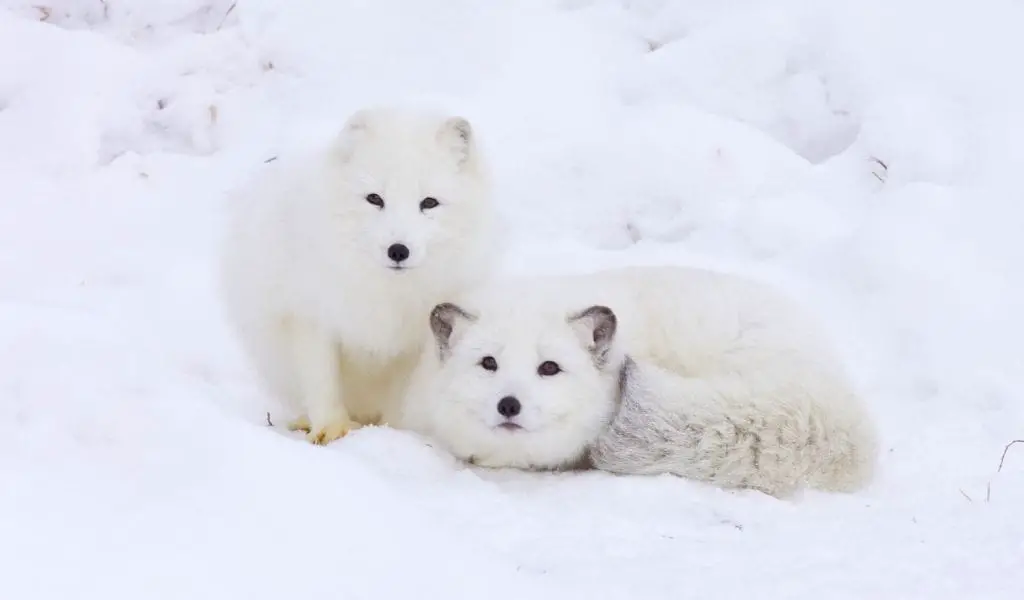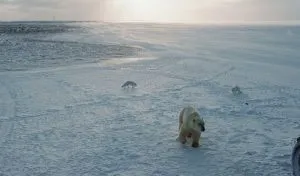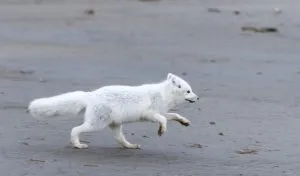The arctic fox (vulpes lagopus) is a mammal that lives in the harsh climate of the arctic tundra. The animal has evolved to be able to survive in these extreme conditions, but still faces many challenges including evading its predators. So, what are the predators of the arctic fox?
Many different animals eat arctic foxes, including red foxes, polar bears, grizzly bears, wolves, golden eagles, and humans. Most of their predators kill arctic foxes to eliminate competition for other food sources, known as intraguild predation.
Arctic foxes are also predators themselves, feeding on small mammals, fish, and birds.
They will usually only live for 3-4 years in the wild whereas they have been known to live for up to 14 years in captivity1(source: Government of Newfoundland and Labrador, Fisheries, Forestry, and Agriculture). Their survival techniques include camouflage and large maze-like dens that help them evade predators.
Are Arctic Foxes Predators or Prey?
Arctic foxes are omnivores, which means they eat both plants and animals. Their diet is different depending upon where they are found.
For example, those found inland prey on small mammals such as lemmings and voles whereas those in coastal areas prey on seabirds, fish, and marine invertebrates. However, they also eat berries, seaweed, and most things they can get their paws on.
Although Arctic foxes are predominately predators, they can also be prey themselves although usually as a last resort when food is scarce. They also experience intraguild predation where those competing for the same resources will prey on them to eliminate competition.
Predators of the Arctic Fox
Red Foxes
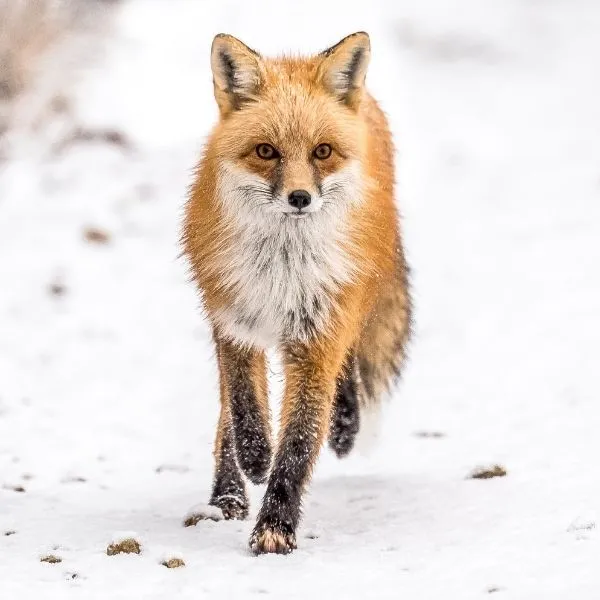
Although part of the same family, red foxes are now the greatest predators of the arctic fox and one of the reasons they are endangered in some regions2 (source: ICUN Red List, 2009). Due to climate change, the camouflage of the arctic fox is less effective in areas where snow cover has reduced so the red foxes are becoming more dominant3 (source: Climate Change Biology, Lee Hannah, 2011).
The rising temperatures have allowed more plant species to spread north which has resulted in large parts of the tundra turning to forest areas. This is less suitable for arctic foxes and favors the red fox.
Because these two species of fox are competing for prey resources, the red foxes attack the arctic foxes which is known as intraguild predation, this has the dual benefit for red foxes as they can feed upon the arctic foxes and can eliminate competitors for their prey.
Arctic foxes are unable to breed within approximately 8km of a red fox den as the red foxes will kill their young4 (source: The Biology and Conservation of Wild Canids, Macdonald and Claudio Sillero-Zubiri, 2004).
Bears

Both polar bears and grizzly bears are natural predators of the arctic fox.
Arctic foxes are not the main prey of Polar bears, this is ringed and bearded seals5 Source: The National Wildlife Federation. Arctic foxes will often follow polar bears around to feed on the carcasses that are left behind.
When food is in good supply, polar bears won’t hunt arctic foxes as they are harder to catch. However, during the summer months when food is in short supply, the polar bears may prey on the foxes that are following them around.
Bears are threats to arctic foxes because they can dig them out from their den6Source: Government of Newfoundland and Labrador, Fisheries, Forestry and Agriculture..
Wolves and Wolverines

Similar to arctic foxes, wolves are also part of the candid family of animals. However, they are carnivores and typically feed on larger mammals such as muskoxen and caribou. They can do this as they hunt in packs to capture their prey.
However, studies have also found them to eat arctic fox pups, arctic hare, lemming, and caribou7(source: Exploring the diet of arctic wolves at their northern range limit, Canadian Journal of Zoology, Oct 2017) 8(source: Diet of Arctic Wolves on Banks and Northwest Victoria Islands 1992-2001, Larter, 2013).
Wolverines are very different from wolves because they are part of the weasel family rather than the candid family like wolves and arctic foxes. Wolverines are also considered to be opportunistic carnivores like arctic wolves although they are rarely seen so their behaviors are not well documented. However, they have been observed taking carcasses from fox dens and will often be mobbed by foxes 9(source: Foraging Behaviours of Wolverines at a Large Arctic Goose Colony, Arctic, Vol. 55, No. 2, Jun 2002).
Golden Eagles
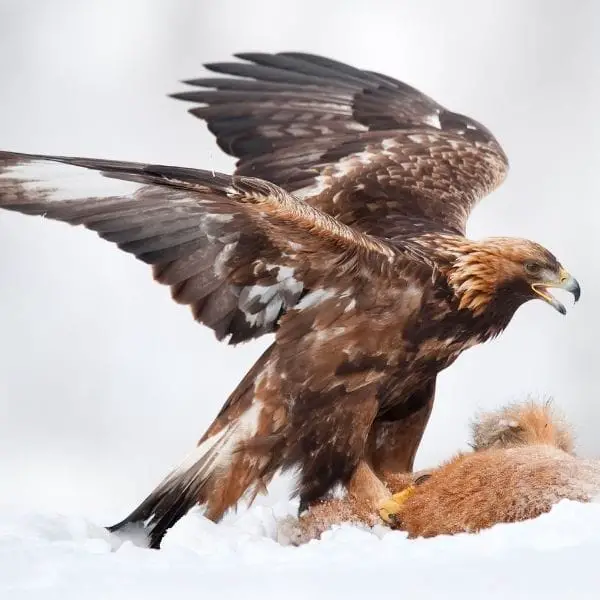
Golden eagles and arctic foxes can compete for the same prey, however, this doesn’t stop golden eagles from hunting arctic foxes too. They are one of the most remarkable predators in the arctic with prey including Dall sheep lambs, young caribou calves, arctic ground squirrels, and foxes10 (source: Alaska Department of Fish and Game). They tear apart larger prey to eat it or carry it back to the nest.
Golden eagles are not the only birds of prey, other predators of arctic foxes from the sky include white-tailed eagles, snowy owls (see below), jaegers, and large hawks11 (source: Predation of arctic fox pups by common ravens, Polar Biology, Nov 2015).
Snowy Owl
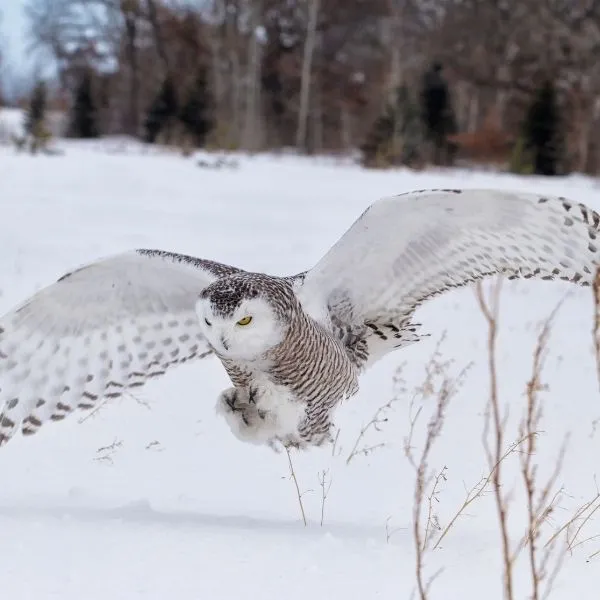
Snowy owls are predators of the arctic fox for similar reasons to the red fox mentioned above. Both snowy owls and arctic foxes are competing predators for lemmings and other small rodents so they will try to get rid of the competition if possible.
As these harsh and cold environments require conservation of energy, they will often act passively to one another. Although, when food is in short supply they are forced to compete with one another.
This Youtube video shows footage captured of a snowy owl and an arctic fox seemingly playing with one another, but in fact, they are defending their territory
According to the Swedish Arctic Fox Project12 (source: National Geographic), snowy owls are very tough and will usually win this battle with no problem killing arctic fox kits.
However, it works both ways between these two competitors. Arctic foxes are also known to eat the eggs of snowy owls and on rare occasions have been known to kill owls themselves.
Humans
Although humans don’t tend to hunt arctic foxes for food, they have been a huge target in the past for their fur. However, according to WWF13 (source: WWF), this has become less of an issue as demand for fur has drastically decreased in recent times. Although, native locals still hunt arctic wolves so that they can use their fur for warmth.
What Does an Arctic Fox Do When it Meets a Predator?
Arctic foxes do their best to avoid being seen by predators. They are able to blend in with the landscape and remain very still. Being part of the candid family means their hearing is second-to-none so they will quickly scarper when they hear predators.
If they do encounter predators such as a polar bear, they are easily able to outrun it with a top speed of 50kph compared to the polar bears 40kph14 (source: Sealife). However, aerial attacks are harder to defend and a golden eagle will easily win in the open space.
This is why they dig dens which they can quickly hide in. They have many tunnels to evade predators and will protect their young in here too.
What Does an Arctic Fox Eat?
The diet of arctic foxes varies depending upon their habitat although can be roughly segregated into inland and coastal diets.
Those that live inland will have a diet of small mammals, mainly rodents such as lemmings and voles. Whereas those that live in coastal areas will prey on seabirds, fish and other marine invertebrates bought in by the sea.
They are considered to be opportunistic omnivores as they will eat almost anything they can get hold of. This can include berries, seaweed, carcasses, and feces of other animals.
Read our full guide to find out more about what arctic foxes eat.
Related Questions
How Do Arctic Foxes Survive?
Arctic foxes have adapted to survive in the harsh environment of the arctic tundra.
One of these adaptations includes a coat that changes color with the seasons. In winter, they have white fur to help them camouflage against the snow and in summer they shed this to reveal brown and yellow fur to blend in against the rocky terrain.
To protect themselves against predators such as bears that can often dig them out of their den, arctic foxes build large dens with many routes like a maze to help them quickly escape and evade predators.
How Long Do Arctic Foxes Live?
In the wild, arctic foxes have a lifespan of 3-4 years, this means they will only experience one year of abundant food in their lives. Pup mortality is not uncommon due to starvation and predation at a time when they are most vulnerable15 (source: Predation of arctic fox pups by common ravens, Polar Biology, Nov 2015).


